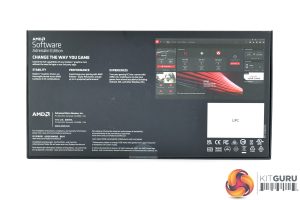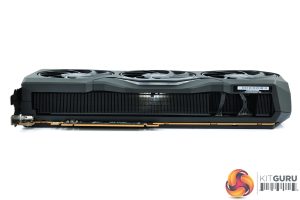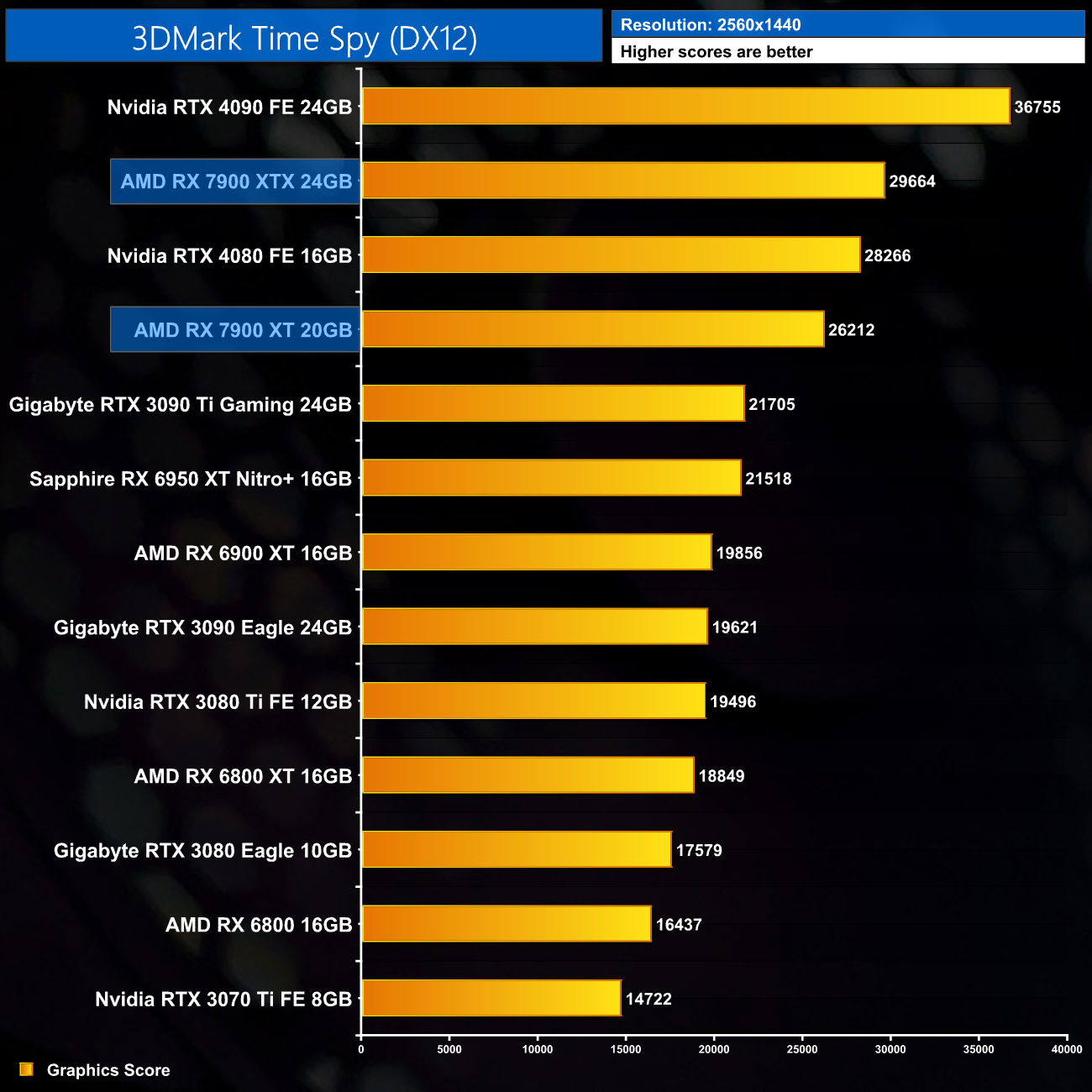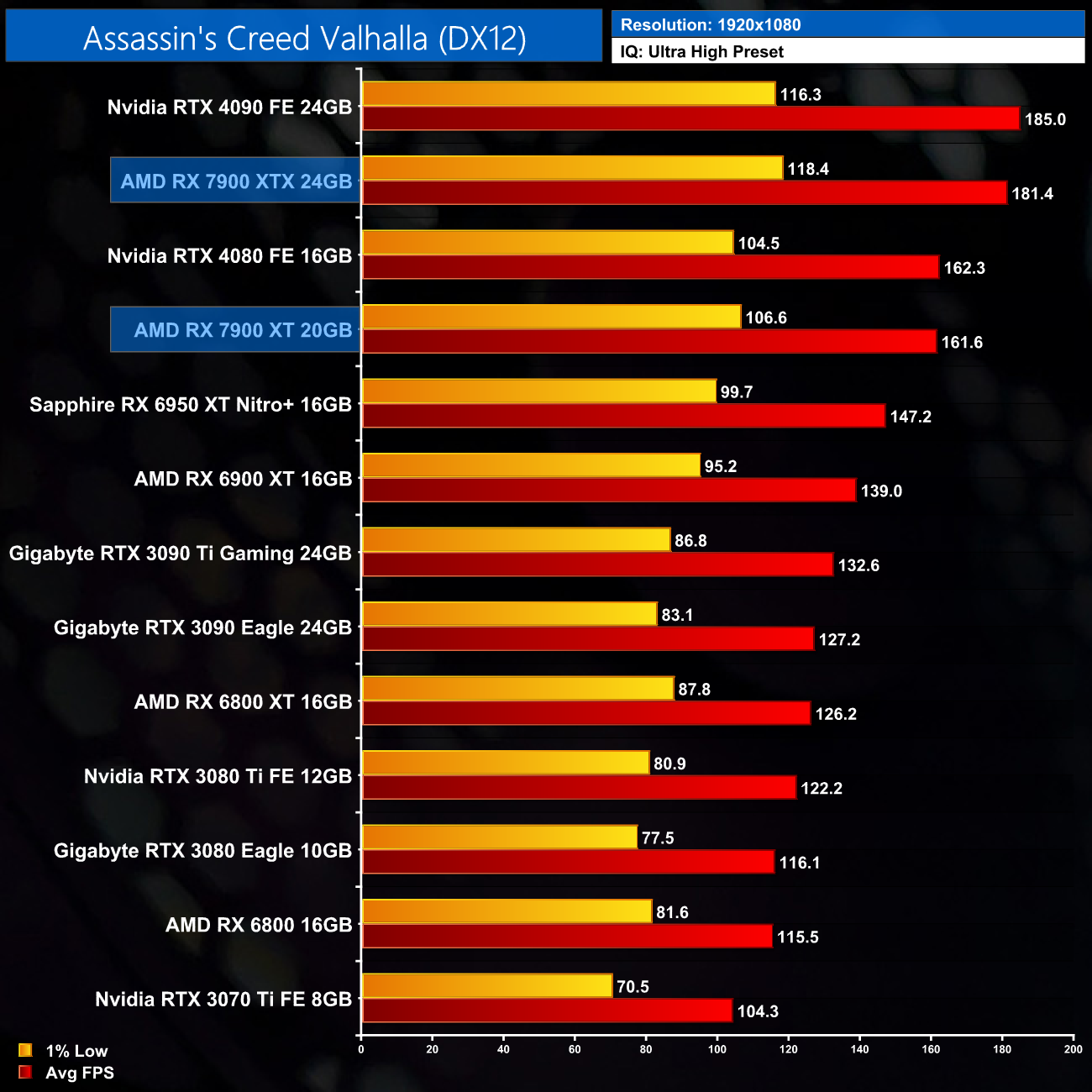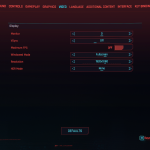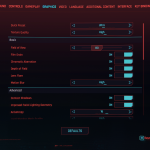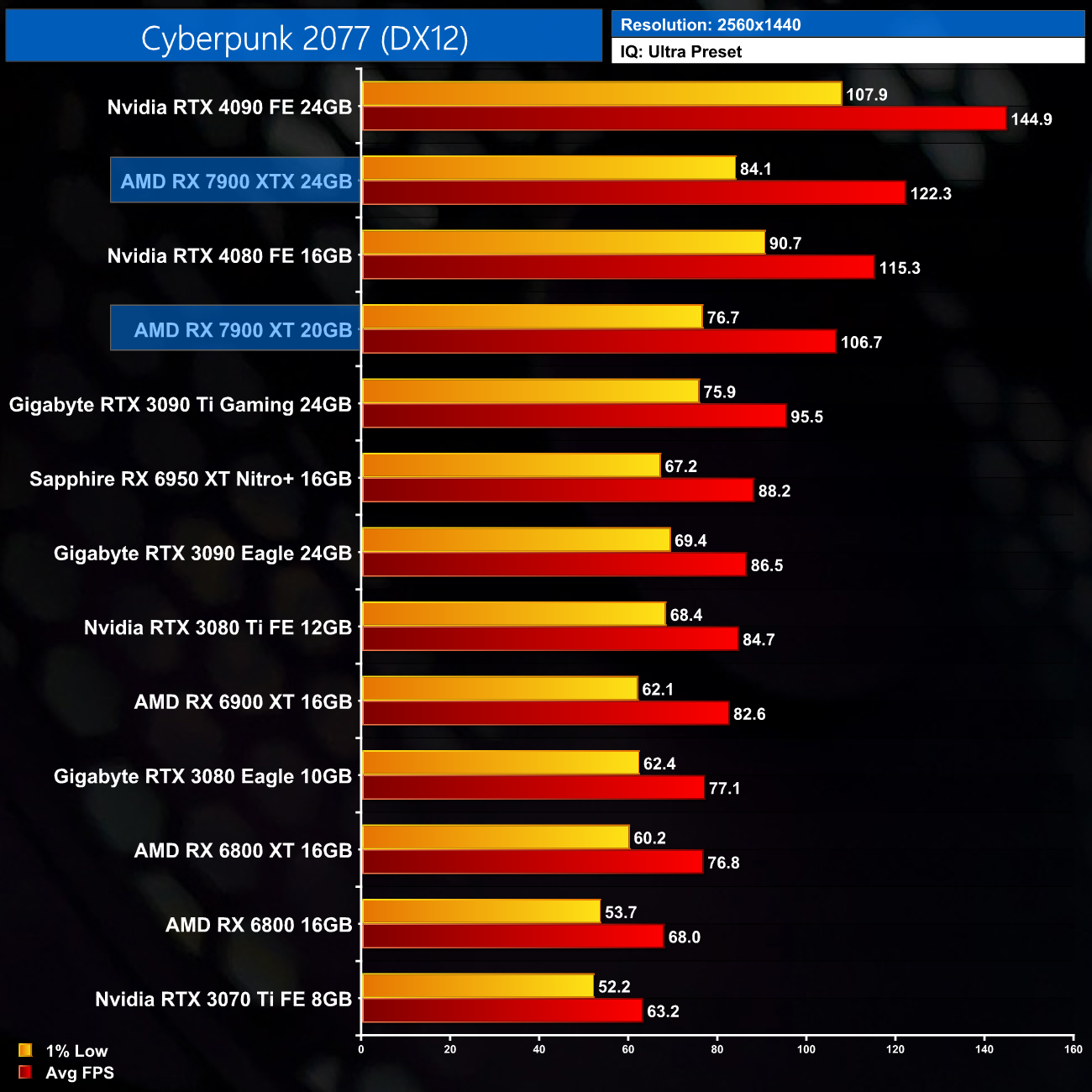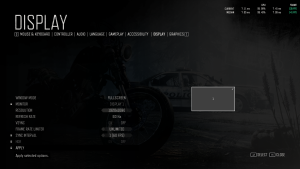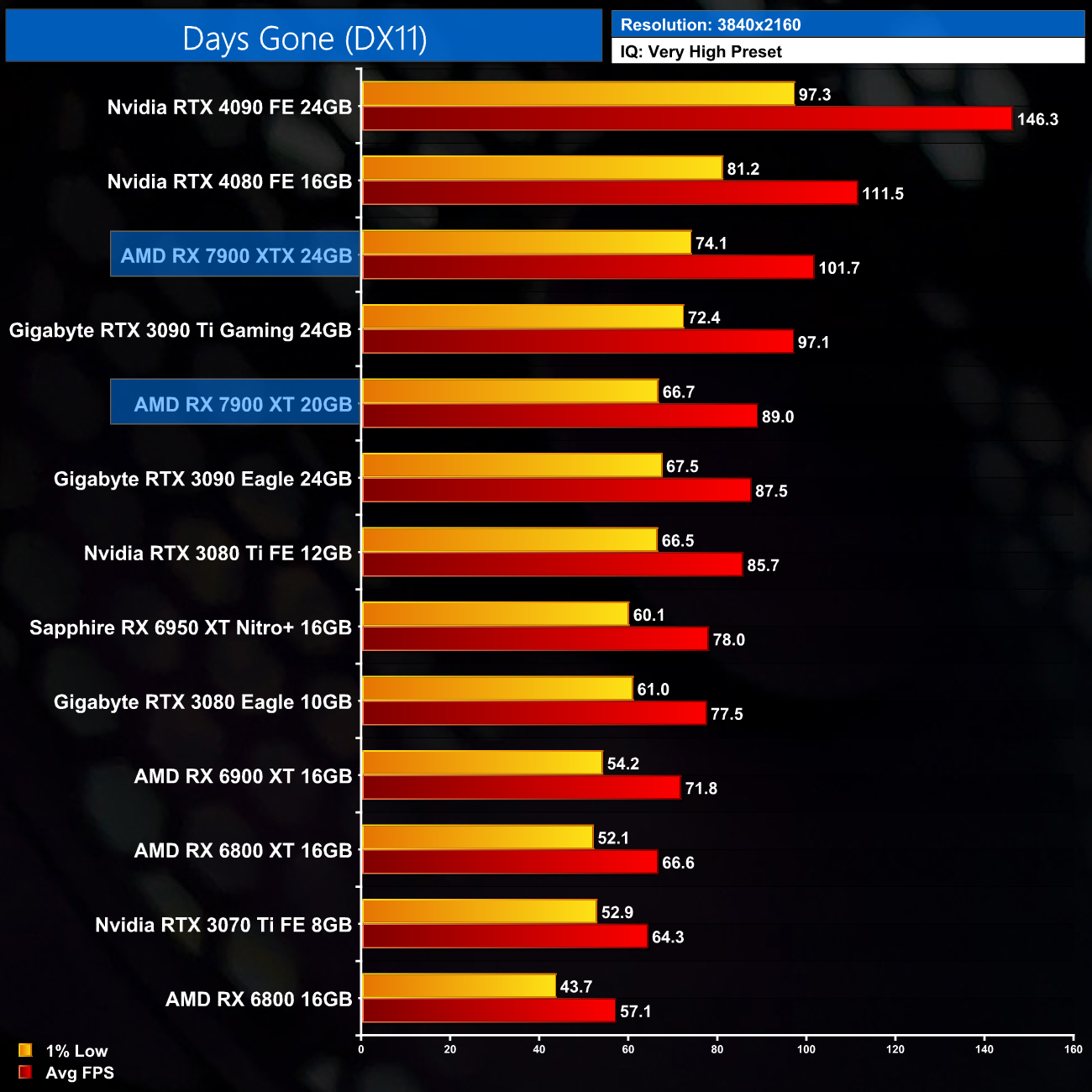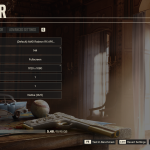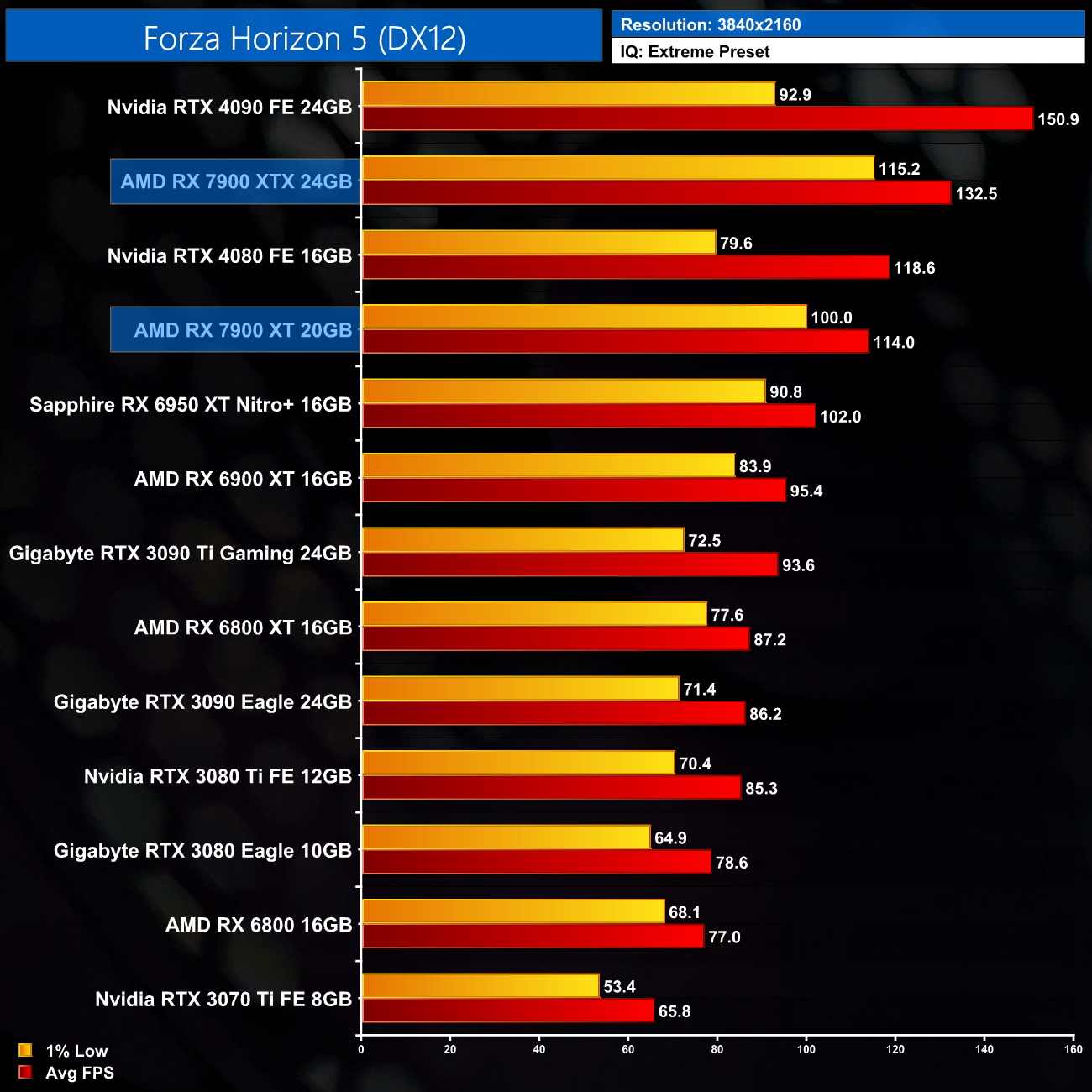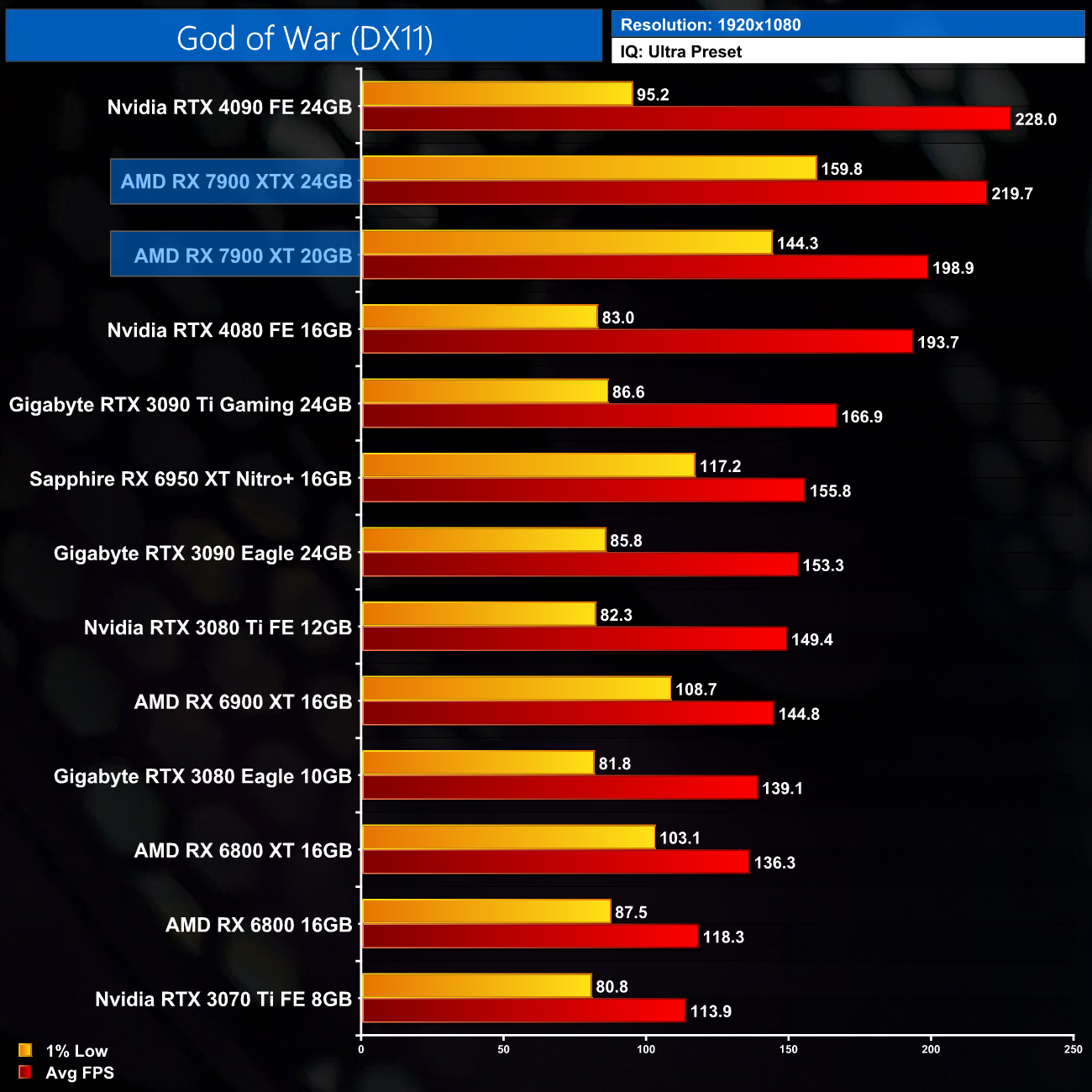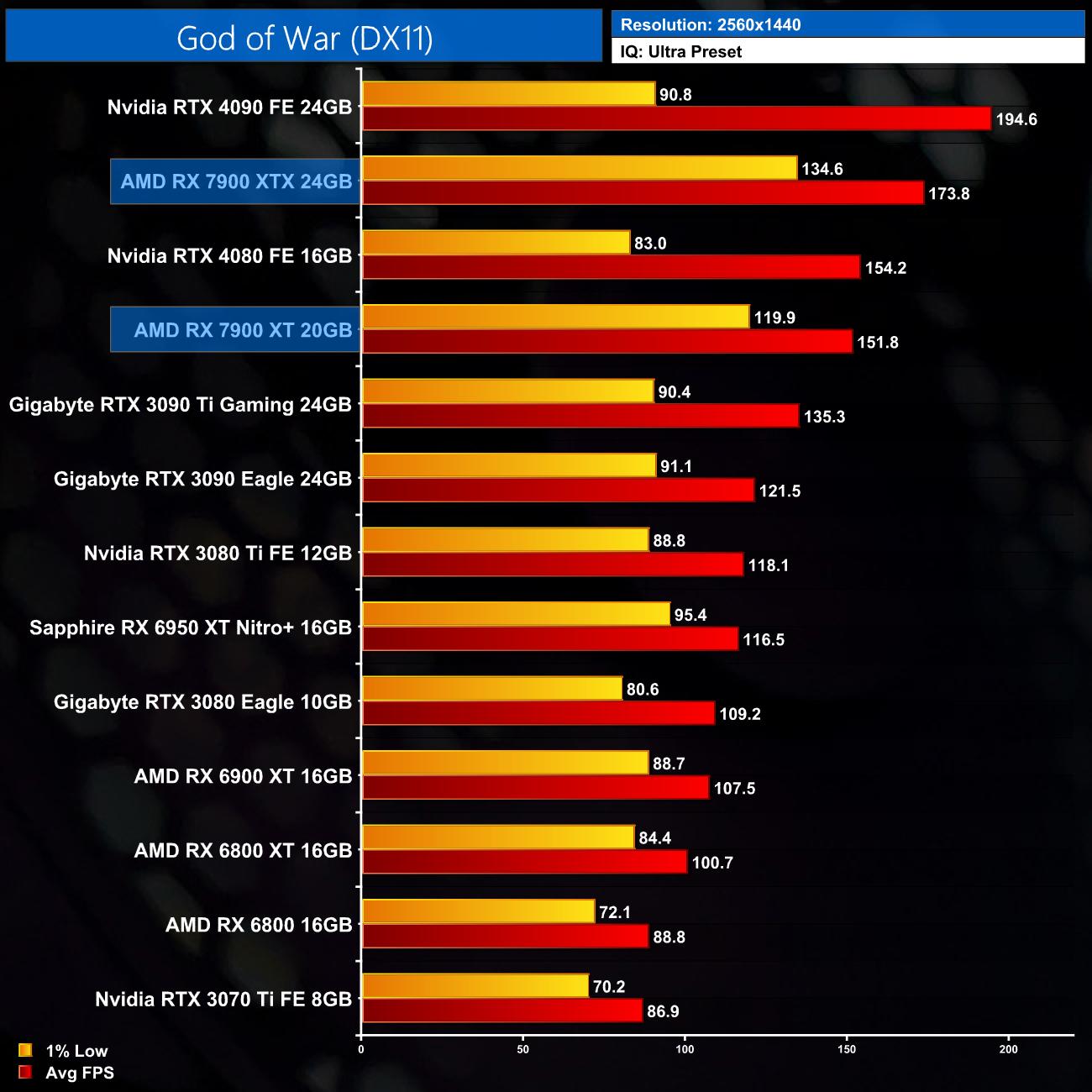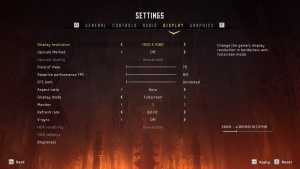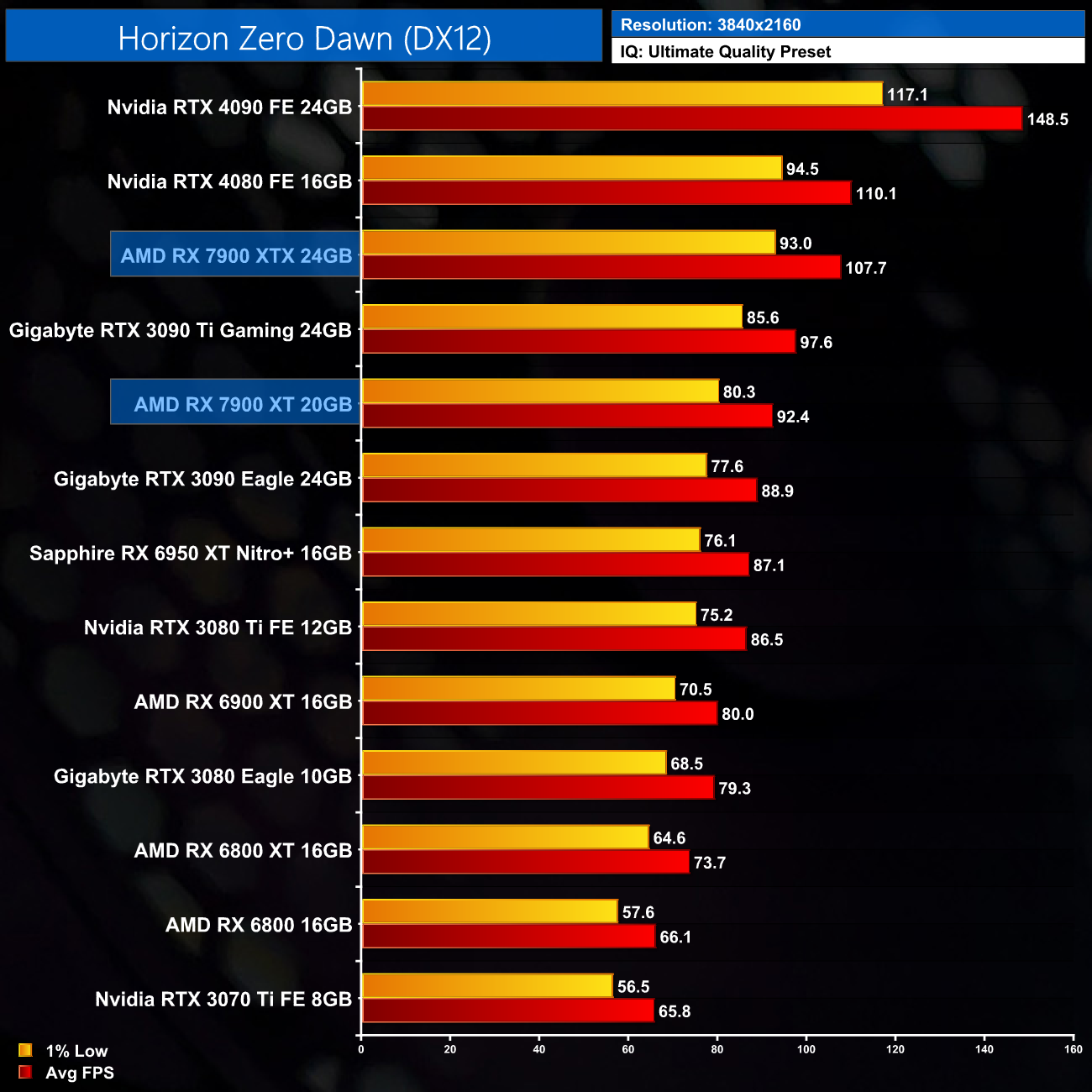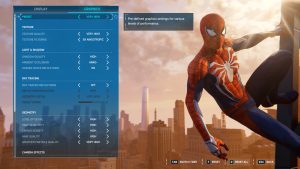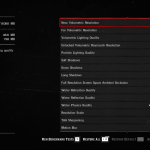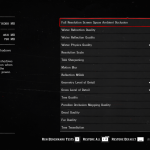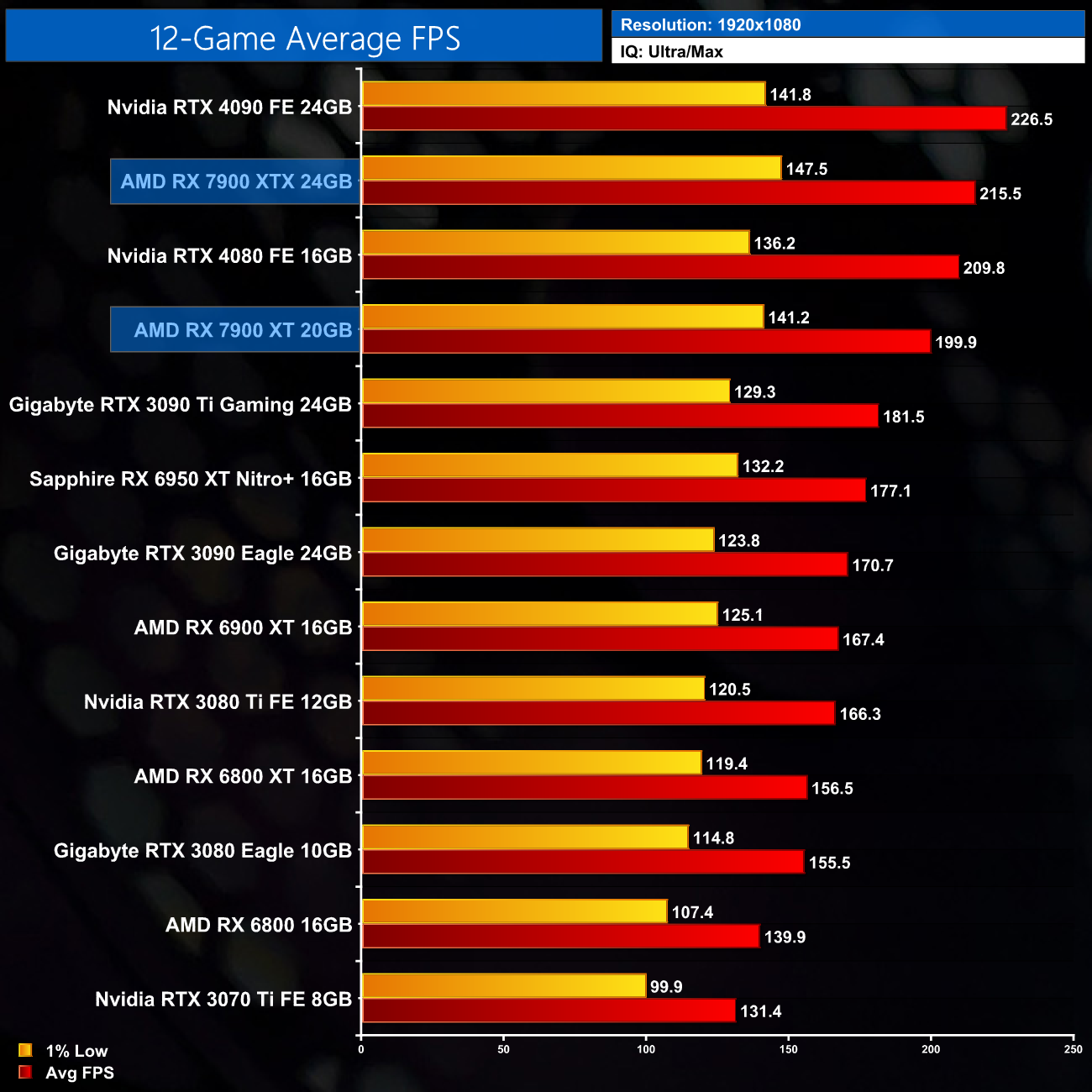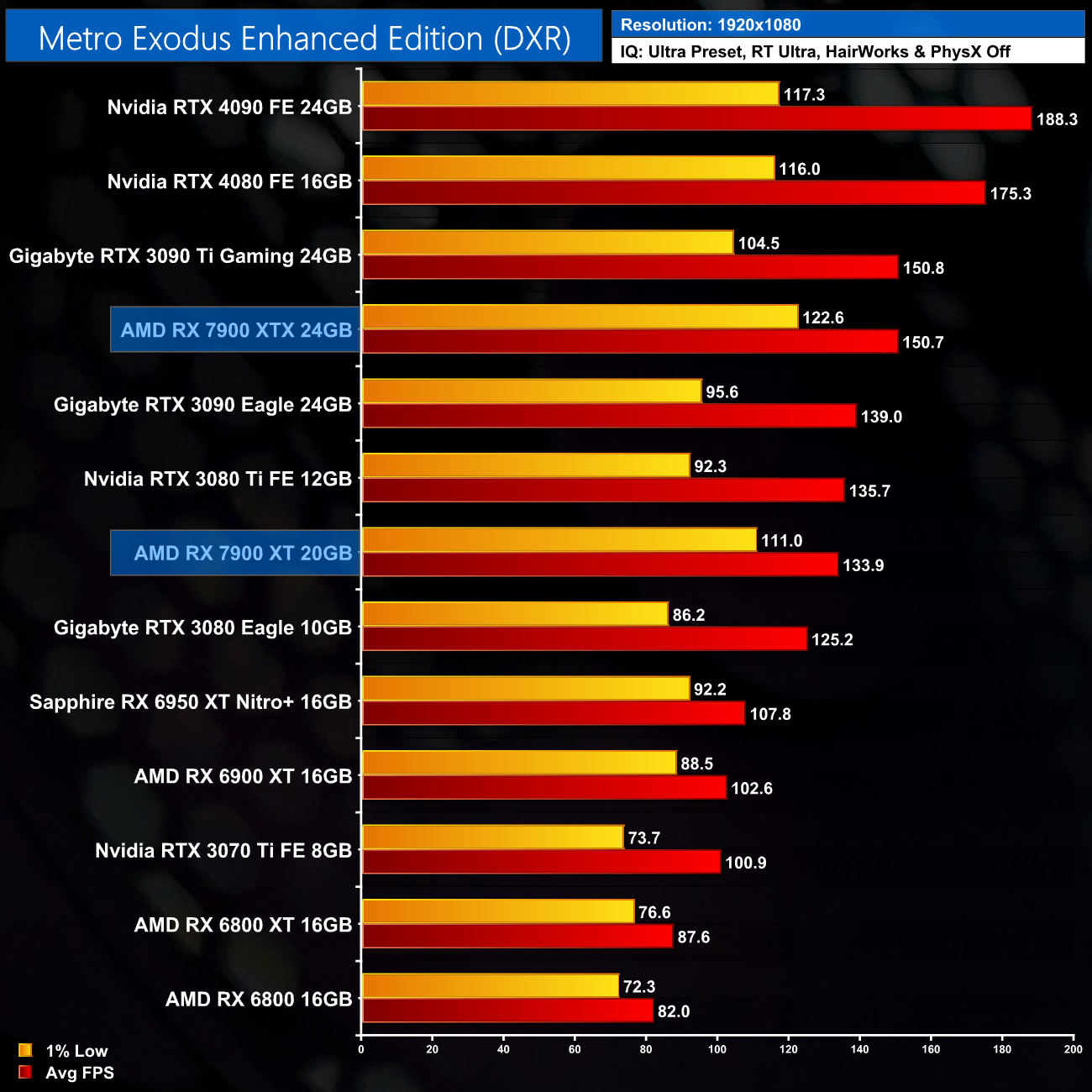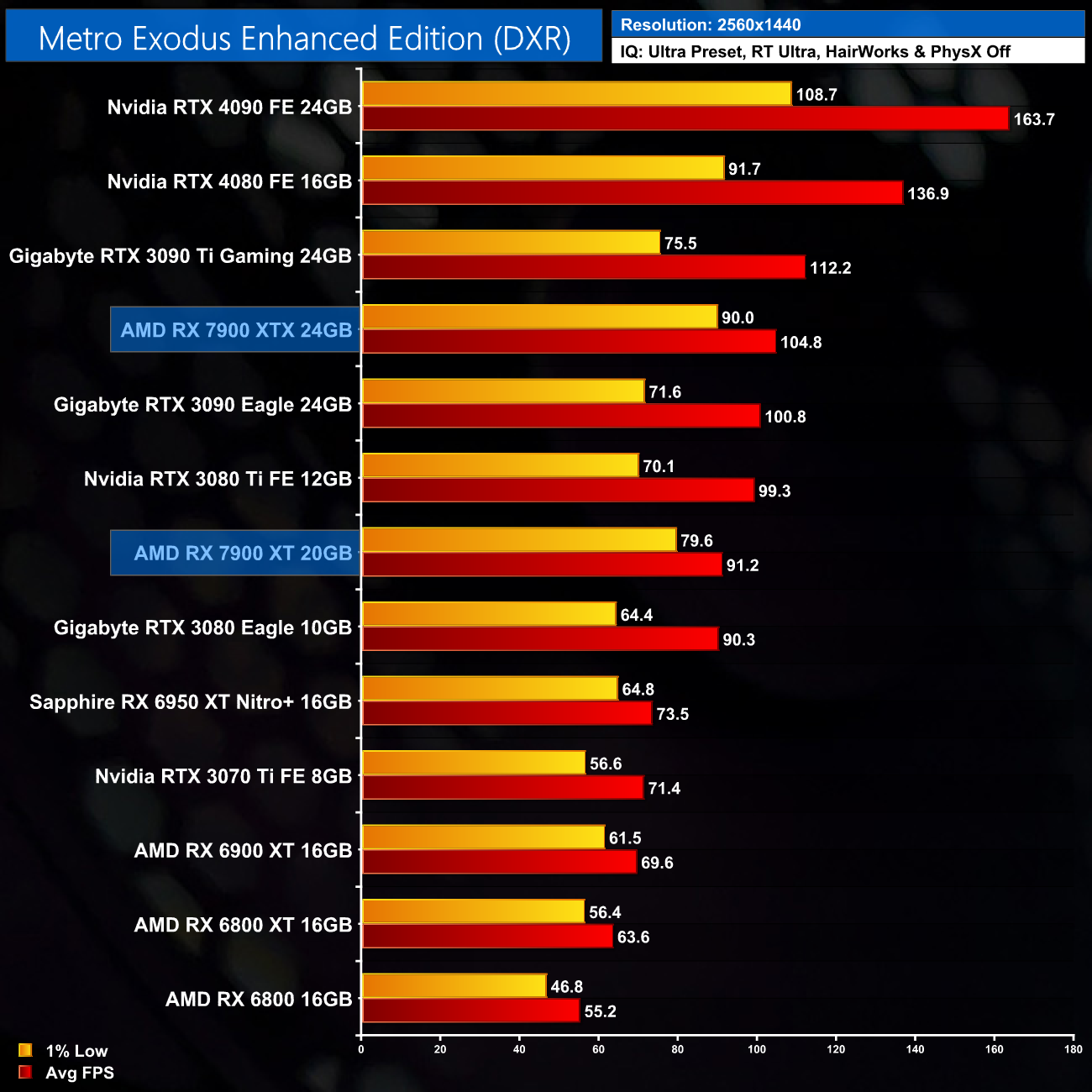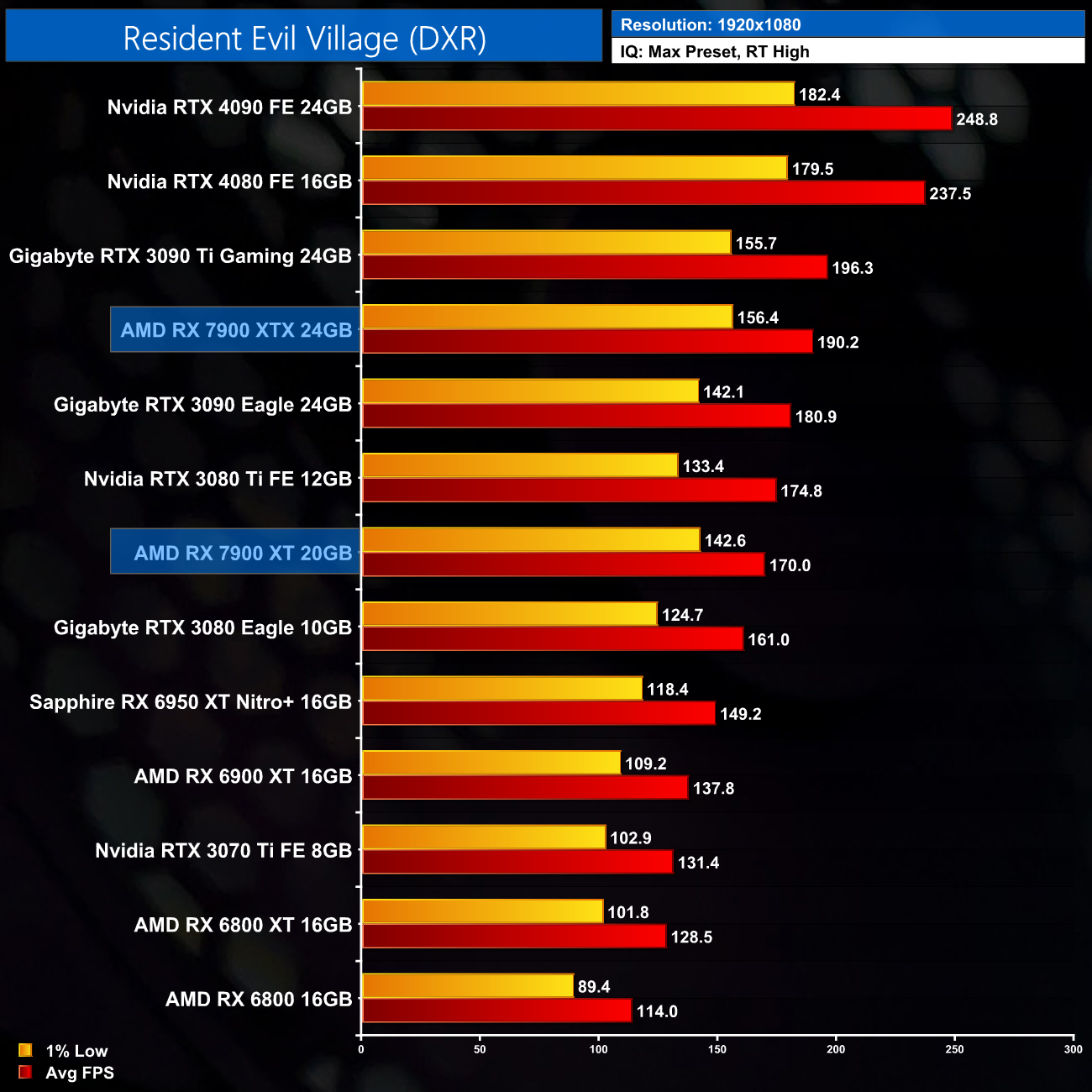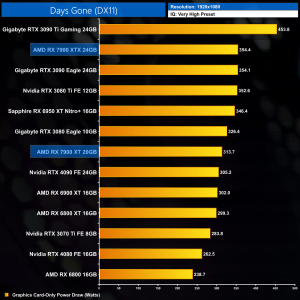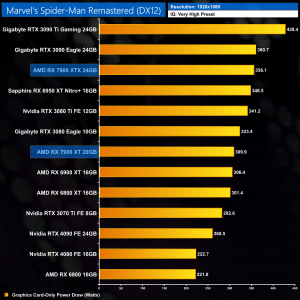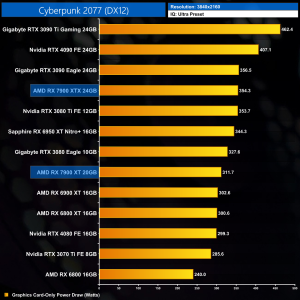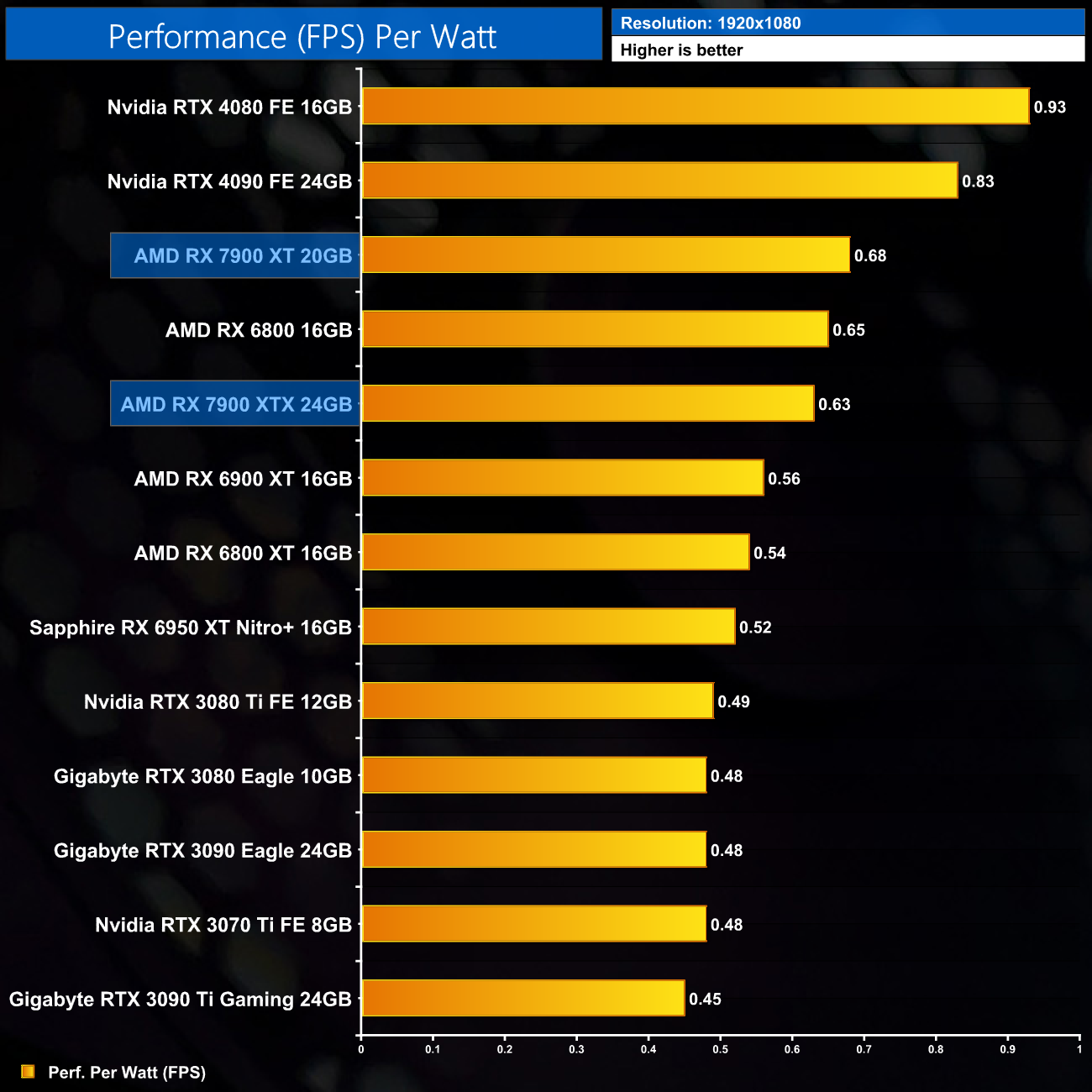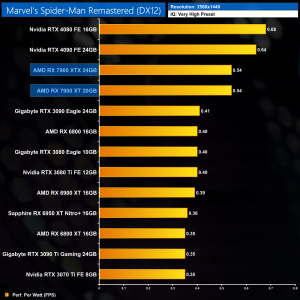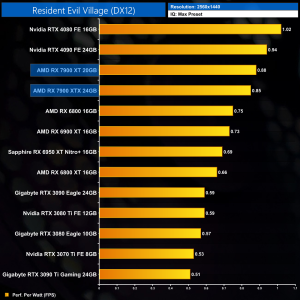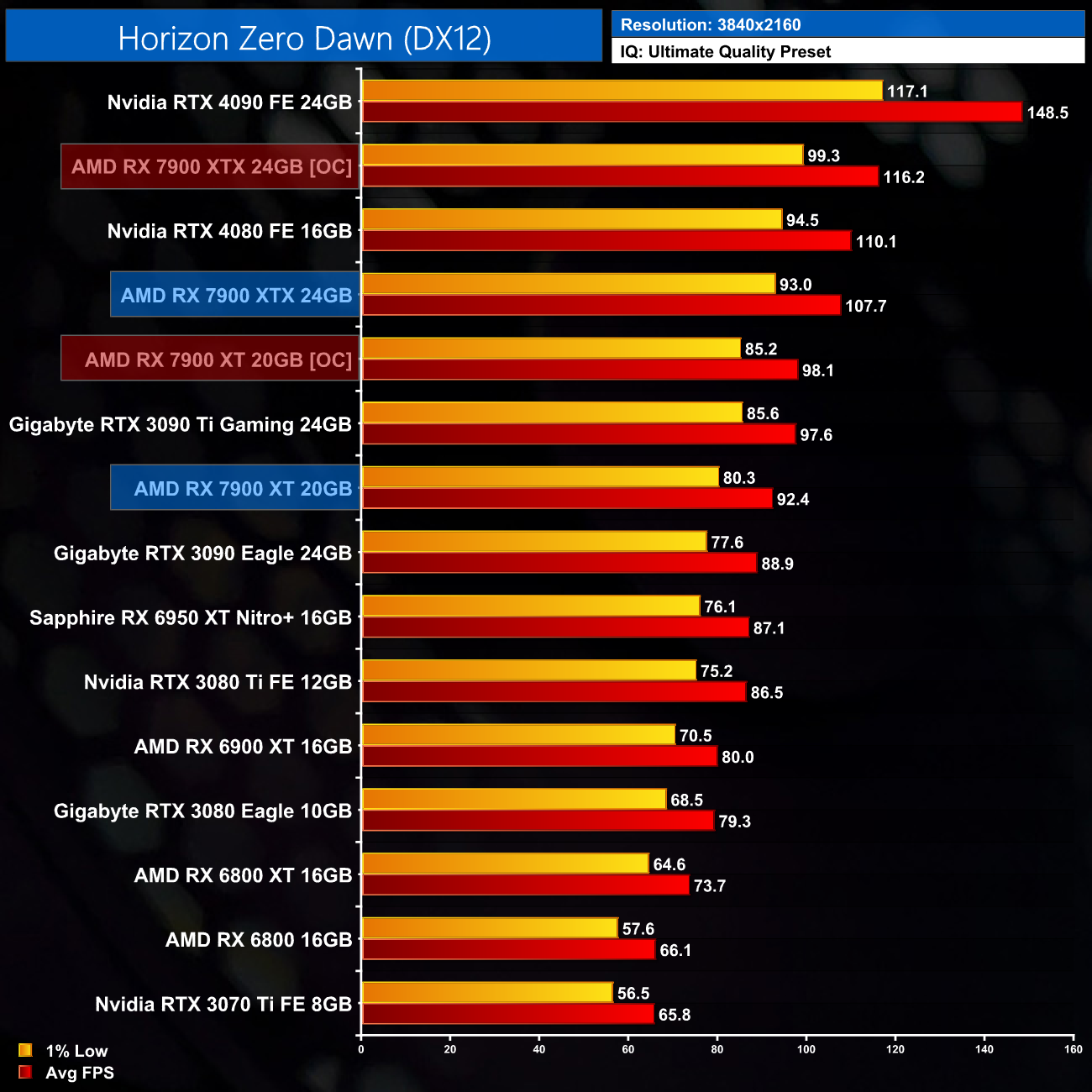
We have been eager to get hands on with the RX 7900 XTX ever since it was officially announced last month at AMD's event in Las Vegas. Priced at £999.99, this new flagship graphics card promises to outperform the more expensive RTX 4080 in rasterised games, while AMD also claims competitive ray tracing performance. Today we put the 7900 XTX through its paces and find out exactly how fast this GPU really is.
Following in the footsteps of the successful RDNA 2 architecture, AMD's new RX 7900 series products are built on RDNA 3, utilising the world's first chiplet-based gaming GPUs. The Radeon RX 7900 XTX is the company's new flagship, promising high performance at a lower price than the previous RX 6950 XT.
AMD is keen to emphasise improvements in power efficiency too, with a claimed 54% increase in performance per Watt versus RDNA 2. We know that Nvdia's Ada Lovelace architecture is itself highly efficient so it will be interesting to see how the RX 7900 XTX compares.
It's also worth noting that while this is a standalone review for the RX 7900 XTX, we do also have a day one review for the RX 7900 XT, and you can find that HERE.
If you want to read this review as a single page, click HERE.
| RX 7900 XTX | RX 7900 XT | RX 6950 XT | RX 6900 XT | RX 6800 XT | RX 6800 | |
| Architecture | RDNA 3 | RDNA 3 | RDNA 2 | RDNA 2 | RDNA 2 | RDNA 2 |
| Manufacturing Process | 5nm GCD + 6nm MCD | 5nm GCD + 6nm MCD | 7nm | 7nm | 7nm | 7nm |
| Transistor Count | 57.7 billion | 57.7 billion | 26.8 billion | 26.8 billion | 26.8 billion | 26.8 billion |
| Die Size | 300 mm² GCD 220 mm² MCD | 300 mm² GCD 220 mm² MCD | 519 mm² | 519 mm² | 519 mm² | 519 mm² |
| Ray Accelerators | 96 | 84 | 80 | 80 | 72 | 60 |
| Compute Units | 96 | 84 | 80 | 80 | 72 | 60 |
| Stream Processors | 6144 | 5376 | 5120 | 5120 | 4608 | 3840 |
| Game GPU Clock | Up to 2300MHz | Up to 2000 MHz | Up to 2100MHz | Up to 2015MHz | Up to 2015MHz | Up to 1815MHz |
| Boost GPU Clock | Up to 2500 MHz | Up to 2400 MHz | Up to 2310MHz | Up to 2250MHz | Up to 2250MHz | Up to 2105MHz |
| ROPs | 192 | 192 | 128 | 128 | 128 | 96 |
| AMD Infinity Cache | 96MB | 80MB | 128MB | 128MB | 128MB | 128MB |
| Memory | 24GB GDDR6 | 20GB GDDR6 | 16GB GDDR6 18Gbps | 16GB GDDR6 16Gbps | 16GB GDDR6 | 16GB GDDR6 |
| Memory Bandwidth | 960 GB/s | 800 GB/s | 576 GB/s | 512 GB/s | 512 GB/s | 512 GB/s |
| Memory Interface | 384-bit | 320-bit | 256-bit | 256-bit | 256-bit | 256-bit |
| Board Power | 355W | 315W | 335W | 300W | 300W | 250W |
First, let's take a quick look at the specs. We've already covered the key figures in our announcement article, but it's worth recapping the core details here.
For starters, the RDNA 3 architecture has seen AMD transition to a chiplet-based design – a world first for a gaming GPU. We find a 300mm² Graphics Compute Die, based on TSMC's 5nm node, flanked by six 37mm² Memory Cache Dies. In total, the Navi 31 GPU packs 57.7 billion transistors.
Internally, the GCD makeup hasn't been radically changed compared to what we saw with RDNA 2. That means Navi 31 packs in 96 Compute Units, each of which houses 64 Steam Processors, for a total of 6144 shaders. There's also 96 Ray Accelerators – one per CU – and 192 ROPs.
As for clock speed, AMD has de-coupled the clocks, so the front-end and shaders can operate at different clock speeds in a bid to save power. With the RX 7900 XTX, the shader clock features a rated game clock of up to 2300MHz, and a boost of up to 2500MHz.
Meanwhile, the memory configuration has taken a step forward. The RX 7900 XTX packs 24GB of GDDR6 memory clocked at 20Gbps, operating over a 384-bit memory interface, for total memory bandwidth of 960 GB/s. 96MB of Infinity Cache is also present, which allows AMD to claim an ‘effective memory bandwidth' of up to 3500 GB/s.
Power draw for the RX 7900 XTX is rated at 355W Total Board Power (TBP), but we are using our updated GPU power testing methodology in this review, so read on for our most detailed power and efficiency testing yet.
The AMD Radeon RX 7900 XTX ships in a compact black box. A semi-obscured image of the graphics card is visible on the front, while AMD highlights the Adrenalin software on the back.
Inside, we find only two small pieces of documentation – a quick-start guide and an invitation to sign up to AMD's community forum.
Taking a look at the graphics card itself, I think it is immediately clear that AMD has really stepped up its game with the 7000 series. Yes, the overall design is more of an evolution of the RX 6000 series, rather than a revolution, but the all-black aesthetic is very alluring in my opinion and is much cleaner-looking than the previous black and silver design.
The shroud is also incredibly well built, manufactured with an aluminium alloy, with three 85mm fans sitting within the shroud. The 7900 XTX also features two RGB LED strips, positioned above and below the central fan.
Meanwhile, much has been made of the size of AMD's reference cards, with the RX 7900 XTX measuring 276mm long, 135mm tall, and 2.5 slots thick (approx. 50mm). That is a fair bit smaller than the RTX 4080 Founders Edition, which itself measures 304 x 147 x 61mm.
The front side of the card is left fairly bare, with the aluminium finstack occupying most of the space. A full-length metal backplate can be seen once the card is flipped over, with the Radeon branding printed in grey text towards the I/O bracket.
It's also noteworthy that AMD has opted for two 8-pin PCIe power connectors. Of course this was not a last-minute decision in response to the controversy around the 12VHPWR connector, but it does mean no new cables or adapters are required.
For display outputs, AMD has made the switch to DisplayPort 2.1, offering two full size connectors and DP 2.1 functionality over the USB-C port as well. We also find a single HDMI 2.1 output.
Driver Notes
- All AMD GPUs (except RX 7900 series) were benchmarked with the Adrenalin 22.10.3 driver.
- All Nvidia GPUs (except RTX 4080) were benchmarked with the 526.61 driver.
- RTX 4080 was benchmarked with the 526.72 driver supplied to press.
- RX 7900 XTX and RX 7900 XTX were benchmarked with the Adrenalin 22.40.00.57 driver supplied to press.
Test System:
We test using a custom built system powered by MSI, based on Intel’s Alder Lake platform. You can read more about this system HERE and check out MSI on the CCL webstore HERE.
| CPU |
Intel Core i9-12900K
|
| Motherboard |
MSI MEG Z690 Unify
|
| Memory |
32GB (2x16GB) ADATA XPG Lancer DDR5 6000MHz
CL 40-40-40
|
| Graphics Card |
Varies
|
| SSD |
2TB MSI Spatium M480
|
| Chassis | MSI MPG Velox 100P Airflow |
| CPU Cooler |
MSI MEG CoreLiquid S360
|
| Power Supply |
Corsair 1200W HX Series Modular 80 Plus Platinum
|
| Operating System |
Windows 11 Pro 21H2
|
| Monitor |
MSI Optix MPG321UR-QD
|
| Resizable BAR |
Enabled for all supported GPUs
|
Comparison Graphics Cards List
- Sapphire RX 6950 XT Nitro+ 16GB
- AMD RX 6900 XT 16GB
- AMD RX 6800 XT 16GB
- AMD RX 6800 16GB
- Nvidia RTX 4090 FE 24GB
- Nvidia RTX 4080 FE 16GB
- Gigabyte RTX 3090 Ti Gaming 24GB
- Gigabyte RTX 3090 Eagle 24GB
- Gigabyte RTX 3080 Eagle 10GB
- Nvidia RTX 3070 Ti FE 8GB
All cards were tested at reference specifications.
Software and Games List
- 3DMark Fire Strike & Fire Strike Ultra (DX11 Synthetic)
- 3DMark Time Spy (DX12 Synthetic)
- 3DMark DirectX Raytracing feature test (DXR Synthetic)
- Assassin's Creed Valhalla (DX12)
- Cyberpunk 2077 (DX12)
- Days Gone (DX11)
- Dying Light 2 (DX12)
- Far Cry 6 (DX12)
- Forza Horizon 5 (DX12)
- God of War (DX11)
- Horizon Zero Dawn (DX12)
- Marvel's Spider-Man Remastered (DX12)
- Metro Exodus Enhanced Edition (DXR)
- Red Dead Redemption 2 (DX12)
- Resident Evil Village (DX12)
- Total War: Warhammer III (DX11)
We run each benchmark/game three times, and present mean averages in our graphs. We use FrameView to measure average frame rates as well as 1% low values across our three runs.
Fire Strike is a showcase DirectX 11 benchmark for modern gaming PCs. Its ambitious real-time graphics are rendered with detail and complexity far beyond other DirectX 11 benchmarks and games. Fire Strike includes two graphics tests, a physics test and a combined test that stresses the CPU and GPU. (UL).
3DMark Time Spy is a DirectX 12 benchmark test for Windows 10 gaming PCs. Time Spy is one of the first DirectX 12 apps to be built the right way from the ground up to fully realize the performance gains that the new API offers. With its pure DirectX 12 engine, which supports new API features like asynchronous compute, explicit multi-adapter, and multi-threading, Time Spy is the ideal test for benchmarking the latest graphics cards. (UL).
Things get off to a decent start for the RX 7900 XTX. It's 15% faster than the RTX 4080 in 3DMark Fire Strike, though that lead is cut to 5% in Time Spy and Time Spy Extreme.
Real-time ray tracing is incredibly demanding. The latest graphics cards have dedicated hardware that’s optimized for ray-tracing. The 3DMark DirectX Raytracing feature test measures the performance of this dedicated hardware. Instead of using traditional rendering techniques, the whole scene is ray-traced and drawn in one pass. The result of the test depends entirely on ray-tracing performance. (UL).
3DMark's DXR feature test is a worrying sign of things to come when looking at the 7900 XTX's ray tracing performance. Not only is it 41% slower than the RTX 4080, it's only slightly faster than the RTX 3080 10GB that launched over two years ago, for less money.
Assassin's Creed Valhalla is an action role-playing video game developed by Ubisoft Montreal and published by Ubisoft. It is the twelfth major installment and the twenty-second release in the Assassin's Creed series, and a successor to the 2018's Assassin's Creed Odyssey. The game was released on November 10, 2020, for Microsoft Windows, PlayStation 4, Xbox One, Xbox Series X and Series S, and Stadia, while the PlayStation 5 version was released on November 12. (Wikipedia).
Engine: AnvilNext 2.0. We test using the Ultra High preset, DX12 API.
Kicking off with Assassin's Creed Valhalla, the RX 7900 XT performs well in this title. At 1440p it delivers 150FPS, making it 8% faster than the RTX 4080, and it's only 6% slower than the RTX 4090.
At 4K, the RTX 4090 does pull away and the 7900 XTX is now 12% slower, but it's still delivering nearly 100FPS, while holding a 9% advantage over the 4080.
Cyberpunk 2077 is a 2020 action role-playing video game developed and published by CD Projekt. The story takes place in Night City, an open world set in the Cyberpunk universe. Players assume the first-person perspective of a customisable mercenary known as V, who can acquire skills in hacking and machinery with options for melee and ranged combat. Cyberpunk 2077 was released for Microsoft Windows, PlayStation 4, Stadia, and Xbox One on 10 December 2020. (Wikipedia).
Engine: REDengine 4. We test using the Ultra preset, DX12 API.
Cyberpunk 2077 sees the RX 7900 XTX again out-performing the RTX 4080, this time by 6% at 1440p, though that's in terms of the average frame rates – Nvidia does have an advantage with the 1% lows.
At 4K, the 7900 XTX is only the second GPU tested able to average over 60FPS, and it's 50% faster than the RX 6950 XT in this title.
Days Gone is a 2019 action-adventure survival horror video game developed by Bend Studio and published by Sony Interactive Entertainment for the PlayStation 4 and Microsoft Windows. As part of Sony's efforts to bring more of its first-party content to Microsoft Windows following Horizon Zero Dawn, Days Gone released on Windows on May 18, 2021. (Wikipedia).
Engine: Unreal Engine 4. We test using the Very High preset, DX11 API.
Days Gone is less favourable to the new RDNA 3 GPUs, though we would expect that from a DX11 Unreal Engine title. At 1440p the 7900 XTX is slower than the RTX 4080 by 6%, though over 180FPS is still very impressive.
At 4K however, the XTX falls off slightly, and it's now just 5% ahead of the RTX 3090 Ti, but 9% behind the RTX 4080.
Dying Light 2: Stay Human is a 2022 action role-playing game developed and published by Techland. The sequel to Dying Light (2015), the game was released on February 4, 2022 for Microsoft Windows, PlayStation 4, PlayStation 5, Xbox One, and Xbox Series X/S. (Wikipedia).
Engine: C-Engine. We test using the High preset, DX12 API.
As for Dying Light 2, it's hard to argue with over 170FPS on average at 1440p, with the 7900 XTX neck-and neck with the RTX 4080.
At 4K, the RTX 4080 does drop off somewhat, and the XTX is able to reach a 10% advantage over its Nvidia rival. Versus the RX 6950 XT, we're looking at a 45% generational uplift for the XTX.
Far Cry 6 is a 2021 action-adventure first-person shooter game developed by Ubisoft Toronto and published by Ubisoft. It is the sixth main installment in the Far Cry series and the successor to 2018's Far Cry 5. The game was released on October 7, 2021, for Microsoft Windows, PlayStation 4, PlayStation 5, Xbox One, Xbox Series X/S, Stadia, and Amazon Luna. (Wikipedia).
Engine: Dunia Engine. We test using the Ultra preset, HD Textures enabled, DX12 API.
Far Cry 6 is CPU-limited even at 1440p, though Nvidia GPUs do hit a wall before the AMD GPUs. Still, it's not until we reach 4K resolution that we see meaningful results, with the XTX offering a tidy 13% performance advantage over the RTX 4080, and that's a 30% boost over the 6950 XT.
Forza Horizon 5 is a 2021 racing video game developed by Playground Games and published by Xbox Game Studios. The twelfth main instalment of the Forza series, the game is set in a fictionalised representation of Mexico. It was released on 9 November 2021 for Microsoft Windows, Xbox One, and Xbox Series X/S. (Wikipedia).
Engine: ForzaTech. We test using the Extreme preset, DX12 API.
Nvidia GPUs currently have an issue with the 1% lows in Forza Horizon 5 – something we are told they are actively investigating so we'd hope for a fix soon. Right now though, AMD GPUs offer a much smoother experience, at any resolution, with the 7900 XTX delivering average performance that's only just shy of the RTX 4090 at 1440p, while it's 12% ahead of the RTX 4080 at 4K.
God of War is an action-adventure game developed by Santa Monica Studio and published by Sony Interactive Entertainment (SIE). It was released worldwide on April 20, 2018, for the PlayStation 4 with a Microsoft Windows version released on January 14, 2022. (Wikipedia).
Engine: Sony Santa Monica Proprietary. We test using the Ultra preset, DX11 API.
AMD GPUs have the upper hand in terms of the 1% lows in God of War as well, and here the 7900 XTX delivers a 49% boost over its predecessor, the RX 6950 XT.
At 4K Nvidia GPUs do recover somewhat, but the 7900 XTX is still 6% ahead of the RTX 4080.
Horizon Zero Dawn is an action role-playing game developed by Guerrilla Games and published by Sony Interactive Entertainment. The plot follows Aloy, a hunter in a world overrun by machines, who sets out to uncover her past. It was released for the PlayStation 4 in 2017 and Microsoft Windows in 2020. (Wikipedia).
Engine: Decima. We test using the Ultimate Quality preset, DX12 API.
Horizon Zero Dawn is a relatively poor performer for the RDNA 3 GPUs, which is slightly surprising considering how well RDNA 2 scales in this title. At 1440p, the 7900 XTX is just shy of the RTX 4080 in terms of average frame rates, and that is the same up at 4K. It's only 2-3% slower, but Horizon Zero Dawn and Days Gone are the only two games where the 7900 XTX can't beat the 4080 at 4K.
Marvel's Spider-Man Remastered is a 2018 action-adventure game developed by Insomniac Games and published by Sony Interactive Entertainment. A remastered version of Marvel's Spider-Man, featuring all previously released downloadable content, was released for the PlayStation 5 in November 2020 and for Microsoft Windows in August 2022. (Wikipedia).
Engine: Insomniac Games Proprietary. We test using the Very High preset, DX12 API.
Marvel's Spider-Man Remastered is an impressive game for RDNA 3, with the 7900 XTX over 50% faster than the 6950 XT at 1440p, while it's 8% faster than the RTX 4080.
Up at 4K, it does fall off slightly, as the XTX is now just 4% faster than the 4080, so performance is basically the same.
Red Dead Redemption 2 is a 2018 action-adventure game developed and published by Rockstar Games. The game is the third entry in the Red Dead series and is a prequel to the 2010 game Red Dead Redemption. Red Dead Redemption 2 was released for the PlayStation 4 and Xbox One in October 2018, and for Microsoft Windows and Stadia in November 2019. (Wikipedia).
Engine: Rockstar Advance Game Engine (RAGE). We test by manually selecting Ultra settings (or High where Ultra is not available), TAA, DX12 API.
Red Dead Redemption 2 is another decent showing for RDNA 3 though, with the 7900 XTX averaging over 160FPS at 1440p, where it's 8% faster than the RTX 4080.
At 4K, it stretches its legs somewhat and beats the RTX 4080 by a 14% margin, the biggest difference between the two GPUs that we will see today.
Resident Evil Village is a survival horror game developed and published by Capcom. The sequel to Resident Evil 7: Biohazard (2017), players control Ethan Winters, who is searching for his kidnapped daughter; after a fateful encounter with Chris Redfield, he finds himself in a village filled with mutant creatures. The game was announced at the PlayStation 5 reveal event in June 2020 and was released on May 7, 2021, for Windows, PlayStation 4, PlayStation 5, Xbox One, Xbox Series X/S and Stadia. (Wikipedia).
Engine: RE Engine. We test using the Max preset, with V-Sync disabled, DX12 API.
As for Resident Evil Village, the 7900 XTX delivers over 300FPS at max settings at 1440p, and is only just shy of the RTX 4090, though that GPU is definitely being bottlenecked by the CPU.
At 4K though we still get 180FPS with the XTX, and it's again 14% ahead of the RTX 4080 while also delivering 40% more FPS than the 6950 XT.
Total War: Warhammer III is a turn-based strategy and real-time tactics video game developed by Creative Assembly and published by Sega. It is part of the Total War series, and the third to be set in Games Workshop's Warhammer Fantasy fictional universe (following 2016's Total War: Warhammer and 2017's Total War: Warhammer II). The game was announced on February 3, 2021 and was released on February 17, 2022.(Wikipedia).
Engine: TW Engine 3 (Warscape). We test using the Ultra preset, with unlimited video memory enabled, DX11 API.
Last of all we come to Total War: Warhammer III. The 7900 XTX is slightly faster than the RTX 4080 on average at 1440p, though its 1% lows aren't quite as smooth.
It's the same story at 4K too, with less than 5% between the XTX and 4080, though the 1% lows lag behind. Versus the 6950 XT however, we se a massive 57% uplift for the RDNA 3 GPU, the biggest generational improvement from the 12 games we've tested.
Here we present frame rate figures for each graphics card, averaged across all 12 games on test today. These figures can disguise significant variations in performance from game to game, but provide a useful overview of the sort of performance you can expect at each resolution tested.
Looking at the big picture overview, the RX 7900 XTX averages just under 181FPS at 1440p. That makes it 5% faster than the RTX 4080, 11% slower than the RTX 4090, while it's a 32% improvement over the RX 6950 XT.
At 4K, the 7900 XTX does look a bit better versus the RTX 4080 as it's 7% faster on average here, but also 19% slower than the RTX 4090. Compared to the previous generation AMD flagship, the XTX is 39% faster than the 6950 XT.
The MSRPs
Using the average frame rate data presented earlier in the review, here we look at the cost per frame using the UK MSRP launch prices for each GPU.
Cost per frame is another key metric. At 1440p, the RX 7900 XTX comes in at £5.54 per frame, which is actually slightly better value than the 7900 XT, and it is very similar to previous-generation cards like the RTX 3080 10GB and RX 6800 XT, though it is 26% cheaper per frame than the 6900 XT.
At 4K, the 7900 XTX is 6% cheaper per frame than the 7900 XT, and basically matches the likes of the RX 6800 XT and RX 6800. It's also a hefty 35% reduction to cost per frame versus the 6950 XT.
Current retail pricing
Based on current pricing however, things don't look as attractive for the 7900 XTX. At 1440p for instance, its overall value is a match for the RX 6900 XT and 6950 XT, both of which can now be found well below MSRP.
At 4K, the XTX does still offer very good overall value, but it's not really much of an improvement gen-on-gen – we're looking at just a 4% improvement versus the 6950 XT using current retail prices.
Here we test Cyberpunk 2077, using the Ray Tracing: Ultra preset. DLSS/FSR are disabled.
Starting our look at ray tracing performance with Cyberpunk 2077, we can't say we are surprised to see the 7900 XTX lagging behind the RTX 40-series. At 1440p, it can barely hold above 30FPS for the 1% lows, delivering similar performance to the RTX 3080, making it 33% slower than the RTX 4080.
Up at 4K, Cyberpunk is too tough for all but the RTX 4090, but even so, performance similar to the RTX 3080 Ti is quite disappointing.
Here we test Marvel's Spider-Man Remastered, with the in-game ray tracing effects set to Very High, Object Range set to 6. DLSS/FSR are disabled.
Marvel's Spider-Man Remastered is a better showing for RDNA 3, however, perhaps as a result of this game's RDNA 2 console roots. With ray tracing enabled, the 7900 XTX still delivers well over 124 FPS, and it's only slightly behind the RTX 4080, though both 40-series GPUs are CPU limited.
Even at 4K though, the 7900 XTX is able to effectively match the RTX 4080, and gen-on-gen it's 55% faster than the 6950 XT.
Here we test Metro Exodus Enhanced Edition, with the in-game ray tracing effects set to Ultra. DLSS/FSR are disabled.
Metro Exodus Enhanced Edition is another tough showing for the RX 7900 XTX. Performance is reasonable enough at 1440p, coming in just ahead of the RTX 3090. It does fall off at 4K though, where it is 29% slower than the RTX 4080, just about matching the RTX 3080 Ti.
Here we test Resident Evil Village, this time testing with the in-game ray tracing effects set to High. DLSS/FSR are disabled.
Resident Evil Village is much lighter on its ray tracing effects, though the 7900 XTX is still 19% slower than the RTX 4080. RDNA 3 closes the gap somewhat at 4K however, with the XTX offering 127FPS on average – making it 8% slower than the 4080.
Here we present the average clock speed for each graphics card while running Cyberpunk 2077 for 30 minutes. We use GPU-Z to record the GPU core frequency during gameplay. We calculate the average core frequency during the 30 minute run to present here.
Looking at clock speeds, the RX 7900 XTX averaged 2578MHz over our thirty minute stress test. So far we've only tested the reference model but we will see how it compares to custom cards in the coming weeks.
For our temperature testing, we measure the peak GPU core temperature under load. A reading under load comes from running Cyberpunk 2077 for 30 minutes.
Thermal performance is no problem for the reference XTX card either. The GPU peaked at 63C, with the hot spot at 81C, with performance overall very similar to the 7900 XT.
We take our noise measurements with the sound meter positioned 1 foot from the graphics card. I measured the noise floor to be 32 dBA, thus anything above this level can be attributed to the graphics cards. The power supply is passive for the entire power output range we tested all graphics cards in, while all CPU and system fans were disabled. A reading under load comes from running Metro Exodus Enhanced Edition for 30 minutes.
We did notice that the 7900 XTX was a touch louder than the XT in use, hitting 41dBa on our sound meter. We saw the fans ramp up to 64%, or 1700rpm during our testing, so it's not a super quiet card but it's not raucous like a Vega reference board. There was also some coil whine from our sample, but nothing major – you can hear this in action in our video review.
Here we present power draw figures for the graphics card-only, on a per-game basis for all twelve games we tested at 1080p. This is measured using Nvidia's Power Capture Analysis Tool, also known as PCAT. You can read more about our updated power draw testing methodology HERE.
Per-Game Results at 1080p:
Click to enlarge.
12-Game Average at 1080p:
Power draw is relatively high at 1080p, with the 7900 XTX drawing 344.7W on average. This is substantially more than the RTX 4080, which draws 228W.
Here we present power draw figures for the graphics card-only, on a per-game basis for all twelve games we tested at 1440p. This is measured using Nvidia's Power Capture Analysis Tool, also known as PCAT. You can read more about our updated power draw testing methodology HERE.
Per-Game Results at 1440p:
Click to enlarge.
12-Game Average at 1440p:
Power draw at 1440p is pretty much bang on the rated 355W TBP, though that is actually more than even the RTX 4090, which draws 334W at 1440p. Nvidia GPUs have a clear advantage in terms of power draw, as they draw significantly less when not fully utilised, whereas RDNA 3 GPUs still draw similar amounts of power even when not fully loaded. Far Cry 6 and Forza Horizon 5 are great examples of this.
Here we present power draw figures for the graphics card-only, on a per-game basis for all twelve games we tested at 2160p (4K). This is measured using Nvidia's Power Capture Analysis Tool, also known as PCAT. You can read more about our updated power draw testing methodology HERE.
Per-Game Results at 2160p (4K):
Click to enlarge.
12-Game Average at 2160p (4K):
Up at 4K, power draw is again in-line with the rated 355W TBP, averaging 355.7W across the 12 games we tested. This is about 75W more than the RTX 4080 (a 26% difference), despite a 7% delta in gaming performance, something which has clear implications for efficiency, as we are about to see.
Using the graphics card-only power draw figures presented earlier in the review, here we present performance per Watt on a per-game basis for all twelve games we tested at 1080p.
Per-Game Results at 1080p:
Click to enlarge.
12-Game Average at 1080p:
Looking now at performance per Watt, 1080p isn't a particularly realistic scenario for these GPUs, but it's interesting nonetheless – the RX 7900 XTX is actually slightly less efficient than the RX 6800, and is quite a ways behind the RTX 40-series GPUs.
Using the graphics card-only power draw figures presented earlier in the review, here we present performance per Watt on a per-game basis for all twelve games we tested at 1440p.
Per-Game Results at 1440p:
Click to enlarge.
12-Game Average at 1440p:
Efficiency at 1440p is improved, though versus the RX 6800, only by a 11% margin. Relative to the RX 6950 XT – RDNA 2's least efficient GPU – we're looking at a 31% improvement in performance per Watt, though it's still 24% less efficient than the RTX 4080.
Using the graphics card-only power draw figures presented earlier in the review, here we present performance per Watt on a per-game basis for all twelve games we tested at 2160p (4K).
Per-Game Results at 2160p (4K):
Click to enlarge.
12-Game Average at 2160p (4K):
Up at 4K, this is where the 7900 XTX is at its most efficient. We can see a generational improvement in performance per Watt of 29% versus the RX 6900 XT, and 35% versus the 6950 XT. Ada Lovelace is the more efficient architecture however – based on the GPUs released so far, at least – as the the 7900 XTX delivers 11% and 14% worse efficiency versus the RTX 4090 and 4080, respectively.
We measure system-wide power draw from the wall while running Cyberpunk 2077 for 30 minutes. We do this at 1080p, 1440p and 2160p (4K) to give you a better idea of total system power draw across a range of resolutions, where CPU power is typically higher at the lower resolutions.
As for total system power draw, we test a range of resolutions to give you an idea of what to expect. This does vary from game to game, as of course CPU load is included in these figures, but we're looking at 580-610W in Cyberpunk 2077 so that gives you a good idea. AMD officially recommends an 800W PSU.
For our manual overclocking tests, we used AMD's built in tuning tool. Our best results are as below.
Our best result came with a 2500MHz minimum GPU frequency and 2900MHz maximum. We increased the VRAM slider to 2730MHz.
This didn't result in much extra frequency for the 7900 XTX, as its average clock speed increased to 2657, so only about an 80MHz improvement.
Gains from this overclock were minimal at best, in the 3-4% region.
That's despite power draw increasing from 354W up to 415.7W when testing Cyberpunk 2077 – a 17% increase.
Interestingly, when reviewing the data logs for this overclock, I noticed that the GPU hot spot temperature had ramped to 100C, peaking at 102C, even with fan speed at 100%. As this is the only 7900 XTX I've tested, it's hard to say if this applies to all XTXs, but I suspect the 415W load is too much for the reference cooler to handle, so clock speed is thermally limited. We'd hope this won't be the case for partner cards which likely have more robust cooling solutions, but only time will tell.
Launch Day Update: AMD has since gotten in touch and given us the following recommended settings for tweaking the XTX :
Undervolt -125mV, +100MHz memclk and +15% powerlimit
It's important to note that we did not try undervolting during our overclocking process, purely due to time constraints, but that could well help the thermals we observed above, while also providing more performance. We will be sure to test this in more detail when we assess partner cards.
It's been a long time coming, and hype has been ever building, but at last we have been able to get hands on with AMD's new flagship GPU, the RX 7900 XTX. There is no doubt this is a good graphics card, though at the same time it hasn't blown me away, nor has it struck a decisive blow against Nvidia.
First and foremost, we can confirm that AMD is offering highly competitive gaming performance in rasterised titles (those which do not utilise ray tracing). Over the twelve games we tested, the 7900 XTX outperformed Nvidia's RTX 4080 by 5% on average at 1440p, and by 7% at 4K. If all you care about is traditional raster performance, then clearly the 7900 XTX is a success, offering better performance than its closest rival for £200 less.
That said, AMD's generational gains may not seem as impressive. After all, the RX 7900 XTX is on average 32% faster than the 6950 XT at 1440p and 39% faster at 4K, while the margins stretch to 42% and 51% against the RX 6900 XT, respectively. It's still a very solid uplift gen-on-gen, but those who saw AMD's 1st party benchmarks and were expecting 50-70% gains over the 6950 XT may be disappointed. Certain games, like Spider-Man Remastered, do show improvements in that ballpark, but other titles including Horizon Zero Dawn show much smaller generational gains across the board.
Ray tracing performance is another matter entirely, and one where AMD continues to lag behind Nvidia. It is worth stressing that ray tracing performance has improved significantly over RDNA 2, so games are overall much more playable with RT enabled… but even then, in titles like Cyberpunk 2077 and Metro Exodus Enhanced Edition, the 7900 XTX is roughly level with the likes of the RTX 3080 and 3080 Ti, so there is still a clear generational divide between Team Red and Team Green.
Of course, how important this is to you will vary from person to person. That said, I do think the landscape has changed, and while I didn't think the relatively poor ray tracing performance was that big of a deal when RDNA 2 launched two years ago, more games than ever now support the technology and that's only going to ramp up as we head into 2023 and beyond.
AMD's new reference design graphics card is another impressive piece of work. We found that the cooler comfortably dealt with the 355W power output, and while noise levels aren't super quiet, they are on par with the likes of the RTX 4090 Founders Edition. I did notice a bit of coil whine in certain situations however, it was nothing awful but was audible over my case fans in certain games.
Speaking of power draw, this is a keen area of interest for me, and in this review we have deployed our in-depth methodology where we test power draw of each GPU across twelve games at three different resolutions (which you can find starting on page 27 of this review). As it turns out, the 7900 XTX draws pretty close to its rated 355W TBP in almost all situations – there are some slight fluctuations here and there, but it averaged 354.5W power draw at 1440p and 355.7W at 4K.
While this does constitute a reasonable step forward in terms of overall efficiency, RDNA 3 does lag behind Ada Lovelace in this regard. Even against the RX 6950 XT, which was RDNA 2's least efficient GPU, we're looking at a 35% improvement to performance per Watt, not quite the claimed 54% uplift. Overall efficiency measured in 14% below the RTX 4080, so right now the overall efficiency crown is back with Nvidia.
Of the two RDNA 3 GPUs launching today however, the RX 7900 XTX is undoubtedly the more appealing. With just a £100 price differential between the two, making the XTX 11% more expensive, it's actually better value too, coming in 13% faster at 1440p and 18% faster at 4K. That's a situation we don't often see, as we'd expect the cheaper card to offer better value, but not so here. On top of that, the XTX is also more efficient at 4K, so it's well worth stumping up the extra hundred quid if the choice is just between these two cards.
That said, whether or not you should pay £999.99 for the RX 7900 XTX is another matter. There's no doubt it offers good value for money if rasterisation performance is your top priority – we've already mentioned how it's slightly faster than the RTX 4080 in this regard, but also £200 cheaper. Personally however, I don't think ray tracing can be ignored, while I'd argue Nvidia has a feature advantage with DLSS, as it's more widely supported than FSR 2 and generally offers slightly better image quality. Right now, AMD also has no answer to DLSS 3 Frame Generation.
Let's not forget that we are comparing the 7900 XTX to the RTX 4080 – a GPU which we are pretty lukewarm on, and one that doesn't offer compelling value for money. In other words, I don't think it would take much more of a price cut for the RTX 4080 to steal some of the 7900 XTX's thunder, as we've already seen it on sale for £1099 here in the UK.
To be clear, AMD has clearly made good strides with the RX 7900 XTX, and it is well worth buying (depending on your priorities). It's just not the conclusive victory for Team Red that many were hoping for.
A final note on stock. We've been in talks with Overclockers UK who reckon they have in about 1000 units, with MBA (Made By AMD) cards ready to ship on December 13. Custom boards are looking thin on the ground however, but we are expecting supply to come through in 2-4 weeks for XT, but slightly longer for XTX.
The 7900 XTX will be available to purchase from OCUK HERE.
Discuss on our Facebook page HERE.
Pros
- Impressive rasterisation performance, second only to the RTX 4090.
- Faster and cheaper than RTX 4080 for rasterised games.
- Ray tracing, while still not always competitive, has at least improved significantly versus RDNA 2.
- Reasonable improvement to efficiency over RDNA 2.
- Better value than RX 7900 XT.
- Sleek reference design, more compact than 4080 Founders Edition.
- DisplayPort 2.1 support.
Cons
- Ray tracing performance, while improved, lags behind Nvidia significantly in certain titles.
- Power draw is fairly high (within 35W of the RTX 4090 at 4K).
- Less efficient than Ada Lovelace/RTX 40-series.
- Still very expensive at £1000.
- Some audible coil whine.
KitGuru says: RDNA 3 has arrived at long last. The RX 7900 XTX is certainly competitive, particularly if playing traditionally-rendered games is your top priority, though it's not a knock-out blow to Nvidia.
 KitGuru KitGuru.net – Tech News | Hardware News | Hardware Reviews | IOS | Mobile | Gaming | Graphics Cards
KitGuru KitGuru.net – Tech News | Hardware News | Hardware Reviews | IOS | Mobile | Gaming | Graphics Cards





